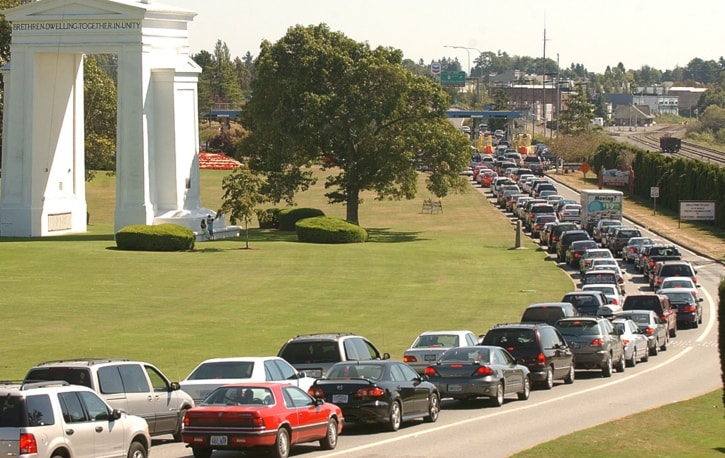The lure of much lower gas prices south of the border is one of the biggest factors attracting Canadians who may spend money on other purchases once they're in the U.S.
Bargain-minded gas shoppers will often find they can pay about 35 cents less a litre by crossing the border, after converting the cost from U.S. gallons to cents per litre and adjusting for the currency differential.
That can add up to savings of about $20 for a typical 60-litre tank full.
The difference in gas price lies almost entirely in the far higher taxes charged on this side of the border.
Drivers in Metro Vancouver pay nearly 50 cents in taxes on every litre – 17 cents to TransLink, 8.5 cents in provincial gas tax to the B.C. government, 10 cents in federal excise tax to Ottawa, 6.67 cents in B.C. carbon tax and five per cent extra in federal GST.
While the carbon tax is revenue-neutral in that it is returned back to taxpayers in lower income tax, B.C. drivers who cross the border to gas up get the benefits of the tax transfer without having to actually pay into it.
According to tax watchdogs, 2012 was the first year Metro Vancouver drivers paid out more than $1 billion in combined gas taxes charged at the pumps.
Over the line in Washington State, drivers are charged the equivalent of an extra 14.8 cents per litre in combined taxes. (The state tax is 37.5 cents per U.S. gallon, while the federal gas tax is 18.4 cents per gallon; there are just under 3.8 litres in a U.S. gallon.)
The state government is proposing to raise gas taxes by 10 cents per gallon, over a five-year period.
"It's just too tempting," Canadian Taxpayers Federation B.C. director Jordan Bateman said. "People can't afford to be patriotic."
Prices generally aren't as low at the U.S. stations closest to the border.
"Anecdotally, it gets cheaper the further you go down into the states," Bateman said.
"But even if you stop at the first gas station you're probably saving 25 cents a litre."
The hefty savings prompt some Canadians to bring multiple jerry cans with them to load up on yet more gas.
Any import of gasoline beyond the capacity of your vehicle is, officially, subject to duty.
But cases abound, as with other purchases south of the border, of Canadian border officials turning a blind eye to vehicles returning stacked with fuel cans.
As for rumours that U.S. gas is lower octane and therefore worse for engines, there's no truth to it, according to Ken Cousin, B.C. Automobile Association's vice-president of road service assistance.
"There's really no statistical difference in the quality of [regular] gasoline," he said. "It's 87 octane."
But he said cross-border gas shoppers may run into different levels of added ethanol.
Canadian gas is allowed to contain a maximum of 10 per cent ethanol, but U.S. stations are allowed to sell higher proportions.
"You want to watch the ethanol concentration," Cousin said, adding a good rule of thumb is to avoid anything higher than 10 per cent.
"When you start getting into 25, 30 and 50 per cent ethanol, it will damage older cars and it's expensive."
Cousin said drivers intending to head to the U.S. to get cheap gas should factor in the extra distance they have to travel and the time idling in border lines in gauging the final extent of their savings.
He also said anyone who crosses the border – no matter for how brief a time – should have travel medical insurance to guard against disastrously high U.S. medical system costs if they have an accident or health problem.
"Things happen," Cousin said. "Even if you're going down for a quick 15 minutes."
Jock Finlayson, executive vice-president of the Business Council of B.C., says the "dramatically higher" gas taxes charged here have almost certainly amplified the "epidemic" of cross-border shopping, although he said it's impossible to say by how much.
He noted that unlike other urban areas in Canada, the B.C. Lower Mainland has one million residents within a 25 to 30 minute drive of the border and many are NEXUS card holders who can bypass long border lines.
"Anything that can be done to reduce fuel-related taxes in B.C./Greater Vancouver would help to mitigate the current leakage of retail spending dollars," Finlayson said.
"But given how big the tax differentials are, it would take a substantial reduction here to make much of a difference."
TransLink's gas tax has proven volatile as some drivers gas up instead in the U.S. or Fraser Valley.
And some Metro Vancouver mayors have said they'd support reducing the gas tax if another source is implemented to replace it – such as road pricing, a vehicle levy or a regional sales tax for TransLink.
But Finlayson doubts that strategy would do much to weaken the pull of cheap U.S. gas.
"Even elimination of the TransLink fuel tax – a far-fetched scenario – would still leave a significant tax disparity due to the B.C. carbon tax and the higher fuel excise taxes charged by B.C. and the federal government compared to what exists south of the border."
